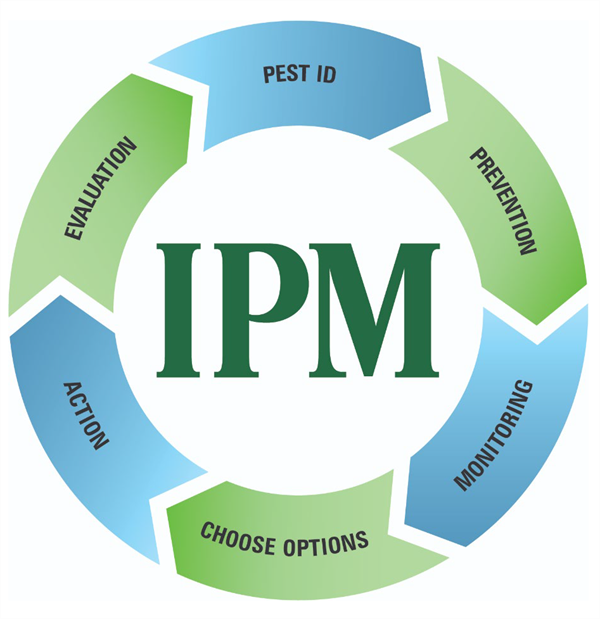Integrated pest management (IPM) involves the utilization of a combination of several tactics for the effective management of pests. This concept was developed by entomologists and is currently adopted by pest managers to target various pests, including insects, weeds, and pathogens. Most IMP tactics fit well in both conventional and organic crop production. It is not uncommon that most pest management techniques (for organic or conventional production) are not very effective as a stand-alone tactic. Therefore, it is essential to use a combination of tactics that will complement each other to control the pests adequately. This is like a “many little hammers” approach, where each of the management tactics is a little hammer hammering on the pests, resulting in a cumulative suppression.
When developing an IPM program, it is important to prioritize planting resistant or tolerant crop varieties and adopting agricultural practices that promote plant health and resilience. Other practices, including physical, mechanical, or biological control, can be implemented to further reduce the pest populations. It is critical to conduct regular scouting to monitor pest populations and use economic thresholds to guide insecticide application decision-making.

Figure 1. Integrated pest management cycle. 1st:pest identification; 2nd: prevention;
3rd: monitoring; 4th: select options; 5th: control action; 6th: evaluation.
Below are some IPM tactics that can be considered in your organic IPM programs:
- Resistant varieties: Resistant varieties are crucial for effective IPM in organic crop production. When available, the use of resistant varieties should be the first line of defense against pests. Resistant varieties help save on production costs and mitigate environmental impacts associated with insecticides and their applications.
- Cultural control: Cultural control includes cropping systems (trap cropping and push-pull), planting date (early planting or late planting), crop rotation, and growing of crop varieties with early maturity traits. Implementing trap cropping and/or push-pull systems can help divert insect pests. Early or late planting, crop rotation, and variety with early maturity traits can help mitigate damaging insect pest pressures.
- Scouting: Proper and timely scouting helps determine the levels of pest infestations, allowing the pest manager to trigger control action in a timely fashion. Scouting also helps to prevent unnecessary insecticide applications.
- Economic thresholds: The economic threshold determines the pest or injury level at which control action should be taken. The economic threshold works side by side with scouting. This helps to determine when a management action should be triggered, allowing a reduction of unnecessary insecticide utilization, which will consequently help in delaying or mitigating resistance.
- Physical/mechanical control: This method includes establishing physical barriers, plowing, and sanitation (elimination of volunteer crops and other potential hosts). Plowing can help to bury soil insect pests deep into the ground, directly kill them, and expose soil insects to adverse weather conditions, birds, and other predators, which will adversely impact these pest populations.
- Biological control: This method involves using insect pests’ natural enemies, including predators such as spiders, lady beetles, syrphid fly larvae, big-eyed bugs, pirate bugs, lacewing larvae, and parasitoids such as parasitic wasps and flies.
- Bioinsecticides: Bioinsecticides are based on botanical extracts, entomopathogenic fungi, entomopathogenic bacteria, or entomopathogenic viruses that have adverse effects on insect pests. Entrust, Bt (Dipel, XenTari, Agree), Pyganic, Aza-Direct, M-Pede, Celite, Surround, Botanigard, Botanigard maxx, Venerate, and more are commonly used insecticides for insect pest control in organic crops.
Implementing IPM will result in economic benefits while preserving the environment and reducing negative impacts on human health. In other words, IPM aims at managing pests in an economically viable, socially acceptable, and environmentally safe manner. It is important to note that not all the IPM tactics are always viable in all situations, and IPM is not a one-size-fits-all solution.
Therefore, the selection of management techniques for an IPM program should be done on a case-by-case basis.
